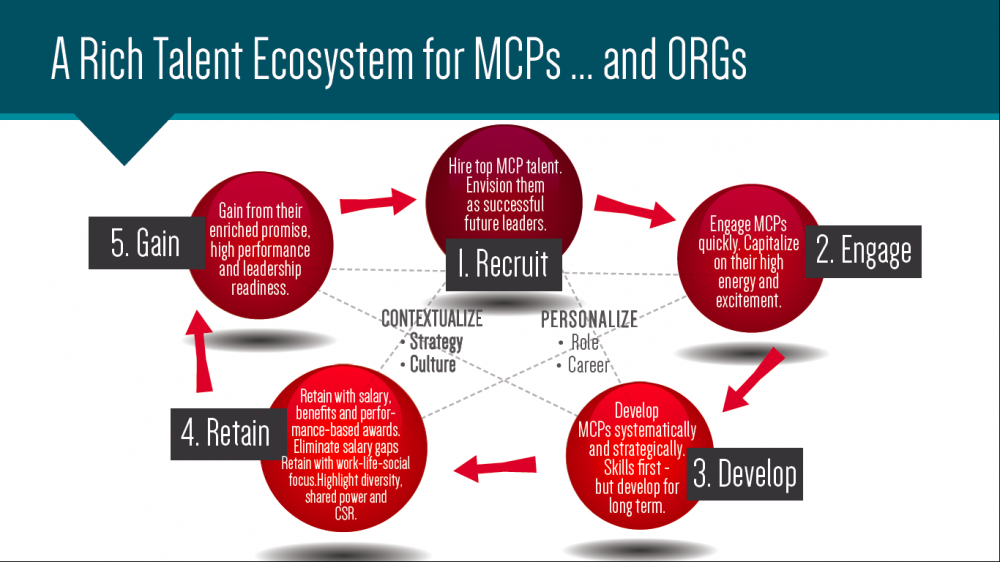
A new study by the Plank Center for Leadership in Public Relations and the Institute for Public Relations revealed three things about millennial communication professionals (MCPs). First, sharp perceptual gaps exist between MCPs and their managers regarding MCPs’ generational attributes, workplace values, engagement, leadership capabilities, and recruitment and retention drivers. Second, some differences (e.g., millennials’ strong values for diversity, transparency and social responsibility) may help enrich the profession. Third, a talent management ecosystem can help organizations attract, engage, develop, retain and gain from top millennial talent.
In this article, we describe the five phases of the talent management ecosystem and demonstrate how a combination of personalized and contextualized approaches in each phase can benefit individual professionals, organizations and the profession.

Recruitment (Phase #1): Be true to the job description and actual work
Nearly two-thirds of MCPs said their job decisions were driven most by an organization’s reputation, location, and its open and positive culture. If these are key factors millennials are seeking, how can organizations appeal to them in meaningful ways? The first rule is that we never provide a job description that’s inconsistent with the actual work. When you offer an integrated package of personal growth and professional development, be careful with your claims.
Make the recruitment a personalized process based on honest job descriptions. Approaches such as including one of your young rock stars in the interviews and hosting a small social/virtual event for the MCPs may deepen commitment and spark results. It’s important to discuss the organization’s diversity initiatives as millennials are the most racially diverse generation in American history. To contextualize recruitment, organizations could position themselves in the community, describe their CSR activities, and share “invisible” culture to bring the organization to life.
Engagement (Phase #2): The goal is to motivate, not simply stick to daily motions
Fortunately, MCPs in our research agreed they generally have a high level of work and organizational engagement, although it was not as high as their managers. They come to the job with excitement and enthusiasm, but these qualities often slide after they stay with the organization for one year. The engagement level dropped to the lowest for those with 1-3 years of experience. Such unfortunate reality in the workplace may drive MCPs to seek other employment due to poor leadership, poor cultural fit, or better financial and career opportunities.
To personalize engagement, organizations might provide a trained mentor, deliver regular feedback, assign a leadership role to the MCPs on small projects, and involve them in a community project. To contextualize engagement, organizations should align each job with company goals and strategy, integrate technology into mentoring, involve MCPs in cross-functional meetings, and require leaders to model engagement.
Development (Phase #3): Transfer their passion for leadership to leadership readiness
Managers said their organizations do a good job in providing mentoring, job-related skills training, and continued education opportunities. However, MCPs said such support is not enough, and they are eager for more leadership development opportunities. Don’t let their passion for leadership slide.
Personalize leadership development by providing continued mentorship programs, offering frequent performance feedback, enriching MCPs’ interpersonal skills, and providing some employee-centered innovation opportunities. At same time, organizations might contextualize such efforts by pairing MCPs with organizational veterans to lead projects, inspiring MCPs by communicating organizational strategy through storytelling, and including them in strategic-thinking and planning initiatives.
Retention (Phase #4): Create your talent pool by adding intangible and tangible values
It is not surprised to see those MCPs who stayed and maintained a consistently high level of engagement give a shout-out to their organization for its open and positive culture, work-life-social balance, commitment to diversity and social responsibility and support for continued development. Moreover, such intangible retention drivers benefit MCPs the most when the traditional financial and performance-based rewards also play a role.
To personalize retention, organizations should share power and decision-making, engage MCPs through cross-specialty projects to build loyalty, provide career counseling, recognize achievements more often, provide flexible work schedules, and support community engagement. To contextualize the process, organization might increase MCPs’ budget responsibilities, insist on equal pay, and provide top-level development programs.
Gains (Phase #5): The long-term benefits
The most tangible consequence of the ecosystem is that organizations and the public relations profession can build a large workforce with great talent. And of course, these personalized and contextualized approaches can be adapted and incorporated into everything the organization does. For millennial professionals who have the desire to make a difference in the community and profession, try leveraging their leadership credentials. Chances are you will engage with someone who shares strong values for transparency, diversity and social responsibility and who can help brighten our professional future.
For the full study, please visit here.
 Juan Meng, Ph.D., is the Director of University of Georgia’s ADPR China Program and Associate Professor in Public Relations at the University of Georgia.
Juan Meng, Ph.D., is the Director of University of Georgia’s ADPR China Program and Associate Professor in Public Relations at the University of Georgia.
 Dr. Bruce K. Berger is a professor emeritus of Advertising & PR at the University of Alabama. In addition to being the Founding Director of The Plank Center for Leadership in PR he also serves as its Research Director. He is also an IPR Trustee.
Dr. Bruce K. Berger is a professor emeritus of Advertising & PR at the University of Alabama. In addition to being the Founding Director of The Plank Center for Leadership in PR he also serves as its Research Director. He is also an IPR Trustee.



